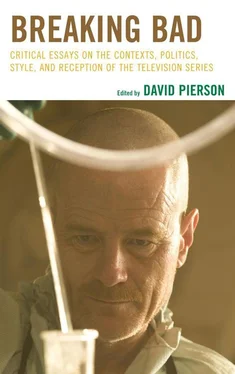In the pilot episode, Walter White is diagnosed with inoperable lung cancer. From that moment on, Walter’s cancer becomes the driving force of the entire series: it is ultimately the explanation of every event affecting every character in every episode. After being blind-sided with the morbid announcement that the main character is terminal, viewers may expect to see Walter become reconciled to his new identity as cancer patient or to see him delivered the miraculous news that he has beaten cancer and is cured. Both story lines would give viewers “feel good” television. Instead, Walter angrily, violently blazes a third path, one which sees him both deny his status as cancer patient while at the same time bitterly insisting on the inevitability of his imminent death. During both the first and second season, Walter’s body makes vivid that Walter is seriously ill. Walter shrinks in size, develops a debilitating hacking cough, loses consciousness, and becomes increasingly frail. Seemingly against his wishes, Walter undergoes treatment. Then, after being told that the cancer has shrunk by eighty percent, Walter submits to, and survives, surgery. And although told that his cancer is then in remission, Walter nonetheless insists that he knows that it is just a matter of time before his doctors will give him unwelcomed news.
Walter is not the only character in Breaking Bad who struggles with having a body that is, to use language found in disabilities scholarship, “undisciplined” or “unruly” (Terry and Urla 1995; Siebers 2008). Indeed, each of the main characters struggle to maintain control over his or her body while presenting a public pretense of normalcy. Skyler, Walter’s wife, regards herself as a good mother—indeed the moral compass for the family—especially when accusing Walter of being deceitful or when discussing his meth-making activities. Yet, on several occasions she seemingly cannot stop herself from smoking while pregnant, drinking, or from having an adulterous affair. Marie, Skyler’s sister, cannot control her kleptomania. Although Hank suffers from post-traumatic stress disorder after witnessing the bombing in Juarez, his later, self-aggrandized version of events is completely false. Later still, after being shot, Hank becomes a hostile paraplegic, fearful that he will no longer be able to function as an officer of the law, or even as a man. Yet, he publically presents himself as confident as ever. Walter Jr., whose cerebral palsy renders his physical impairments most visible, voices the frustrations of a son who cannot understand the disappearance and reappearance of his father in the family home, or the cold war going on between his parents. The stammering speech of Walter Jr. perfectly expresses the slurred rage of a character who wants to, but cannot, fully understand or take control of the situation he is in. As Breaking Bad progresses, each of these characters becomes somewhat, though perhaps not wholly, reconciled with their impairments. Skyler smokes and drinks in front of Walter, rather than secretly in the bathroom, and tearfully acknowledges her flaws as a parent and her frailties as a person. Marie acknowledges her need, and the benefits she has received, from seeing a therapist for her emotional and psychological problems. And Hank, though he initially repeatedly, and rudely, refused offers of assistance from others, came to graciously ask for and accept his longtime (and long-suffering) friend Gomie’s supporting arm to help him walk while at work.
Jesse, Walter’s meth-making partner, starts the series as a drug dealer and drug dependent. Jesse’s life lacks direction; his ‘business’ is sloppily run; he has had many run-ins with the DEA and the local police; and, his knowledge of meth cooking (though he refers to it as an ‘art’) is crude. Although Jesse has a large circle of associates, and a tight circle of friends he can rely on for small favors, he has no one to whom he can turn for real emotional support. While Jesse has moments of sobriety, whenever confronted with trauma (such as the lethal overdose of his girlfriend Jane or the murder of Gale), he spirals into cycle of self-abuse.
In stark contrast to Jesse’s chaotic self-doubt and self-abuse, Walter remains astonishingly unwavering in purpose and unaffected by his experiences. At no point does Walter become reconciled to his cancer status. He neither regards himself as someone living with cancer nor as someone having survived cancer. Indeed, he exhibits an astonishingly level of cognitive dissonance about his cancer, stating on several occasions that his cancer has disappeared and that he is good, but also that he is “dying—we’re all dying .” But this last claim is an empty rationalization, for, although it is true that we are all dying in the sense that we are all mortal , such a claim does not explain anything. And it certainly fails to justify any of the actions that Walter has undertaken since his diagnosis of cancer. Moreover, Walter insists that he is in charge of his life and that cancer does not rule him. This declaration jars in stark contrast with Walter’s frail body, the body that lost consciousness, shriveled in size and coughed up blood. And Walter’s means of maintaining control requires engaging in lies and acts of violence: murder, assault, and repeatedly deceiving his family members about his business. These efforts do not leave Walter unmarked. Walter is seen with bruised ribs, blackened eyes, and a bandaged and bloodied face. Nonetheless, Walter insists that, despite all evidence to the contrary, he is in complete control.
Walter is not terrified of dying, but he is absolutely unwilling to leave his family financially destitute. As a high school teacher, Walter is a rather inadequate provider for his family; they struggle to make ends meet and their financial future is uncertain. Were he to die, though, he would utterly fail to provide for them, making their already precarious situation profoundly worse. [3] To make matters worse, Walter’s medical treatments are extremely expensive, hopelessly beyond his family’s financial means. Thus, not only would his death be leaving a wife and two children without a provider, but if he seeks treatment for his (probably terminal) disease, he will leave his family hopelessly destitute, likely homeless.
To die is to fail, both as a father and a husband. And so, when confronted with the fact of his almost imminent death, Walter assumes a double life and becomes complicit in a series of lies and unspeakably violent crimes. When he begins this double life, Walter does not believe he is going to cheat death, but he does believe he is going to cheat failure. He believes he has found a winning move in a very bizarre game. But the longer Walter plays this game, the higher the stakes become: the longer he keeps up this double life, the more lies he must tell, and the more utterly depraved and immoral he becomes. Ultimately, the harder Walter works to ensure that he becomes the good father and husband he so desperately wants to be, the worse a father and husband he is .
I use three interrelated themes from disability scholarship to analyze Breaking Bad . The first theme, Bodily Control , is that good bodies are controlled bodies and that uncontrolled, messy bodies are frightening, bad bodies. Indeed, the messiness of impairment and disability is so bad, that impaired and disabled individuals are excluded or shut out from many areas of public life. [4] For example, images of impairment and disability are omitted from most forms of advertising unless the advertisements are for charity advertisements or health service magazines. And those images are more negative than positive. Please see Hevey’s chapter on the enfreakment of photography, and Gartner and Joe’s 1998 book on images of the disabled. Public housing rarely accommodates the needs of disabled and employers underemployed individuals with disabilities (Siebers 2008). Public schools still regularly fail to accommodate the needs of students with disabilities. School districts throughout the United States have renamed special education schools as programs. Once so relabeled, test scores from such programs can be excluded from state assessment tabulations and schools districts can then report that students in their schools are meeting federal mandates. As to whether or not the children in educational programs are flourishing, since those test scores are junked, parents have no way to assess either the progress of their own child or compare the merits of one program with another. Despite the fact that a primary purpose of the No Child Left Behind Education Act was to provide parents with the assessment information necessary to ensure that their disabled child’s education was progressing as optimally as possible, administrators around the country have excluded test scores of children with disabilities to ensure those scores will not harm the financial futures of the schools—the effect, however, is that children with disabilities, and their accomplishments, are effectively being erased ( New York Times as quoted in Siebers 2008, 137). Please also see Silver, Wasserman, and Mahowald’s book on disability, difference and discrimination.
The second theme, Normalcy , is that the effect of hiding away impairment, of attempting to conceal disability, is that society becomes defined by, and structured around, the concept of normalcy. Normalcy, being normal, attaining and maintaining normalcy, is the preoccupation of most in society. To fail to be normal, or to fall from what is considered to be normal, is a source of tremendous anxiety for most people. These two themes, Bodily Control and Normalcy are conceptually connected: impairment, disease, and dying are so feared because they are socially invisible and, therefore unknown and unknowable. They are the undiscussable taboos. The third theme, Bodily Realism , is that having a realistic view of the body, which would at minimum require accepting the fact that human bodies are fragile things, prone to disease and accident and are ultimately destined to die, makes one more at ease in the world, and able to live better lives and live as a better person. Indeed, so the argument goes, our lives would be richer, more rewarding—emotionally and morally—if we cared less about normalcy because of a dread of abnormalcy, but instead learned to accept if not positively value the physical variability of human existence.
Читать дальше












